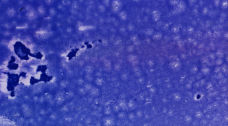47
F 69 y.o.
- FNAC swelling right parotid
Cribriform cystadenocarcinoma
- Low-grade cribriform cystadenocarcinoma is a rare tumor that is recognized as a variant
of cystadenocarcinoma by the 2005 WHO classi?cation. It has an estimated incidence of
2% of malignant salivary gland tumors. Cytological diagnosis of cystadenocarcinoma is
important for differential diagnosis between benign lesions and malignant tumors with
cystic growth.
- FNAC shows a large number of tumour cell clusters in the cystic ?uid. The clusters are
arranged in cohesive aggregates with overlapping. Tumour cells have a small
vacuolated. soap-bubble appearance in the cytoplasm. The papillary-cystic variant of
acinic cell carcinoma (AC C-PCV) is a differential diagnosis.
- Histologically, the tumour was not encapsulated. but fomted large cystic spaces against
a background of ?brous connective tissue. The tumor cells in the cystic dilated duct
showed papillary structures. which were continuous with the lining cuboidal cells. There
was neither a de?nite double-layered arrangement in cystic ducts and solid islands nor
histological ?ndings characteristic of the papillary-cystic or follicular pattern of ACC-
PC V. As tumor cells with a small vacuolated, soap-bubble appearance of the cytoplasm
are common findings of both cystadenocarcinoma and ACC-PC V, they are of little use
for differentiation; however, they are so characteristic that the majority of benign
salivary gland lesions with cystic structures can be excluded, if enough attention is paid.
